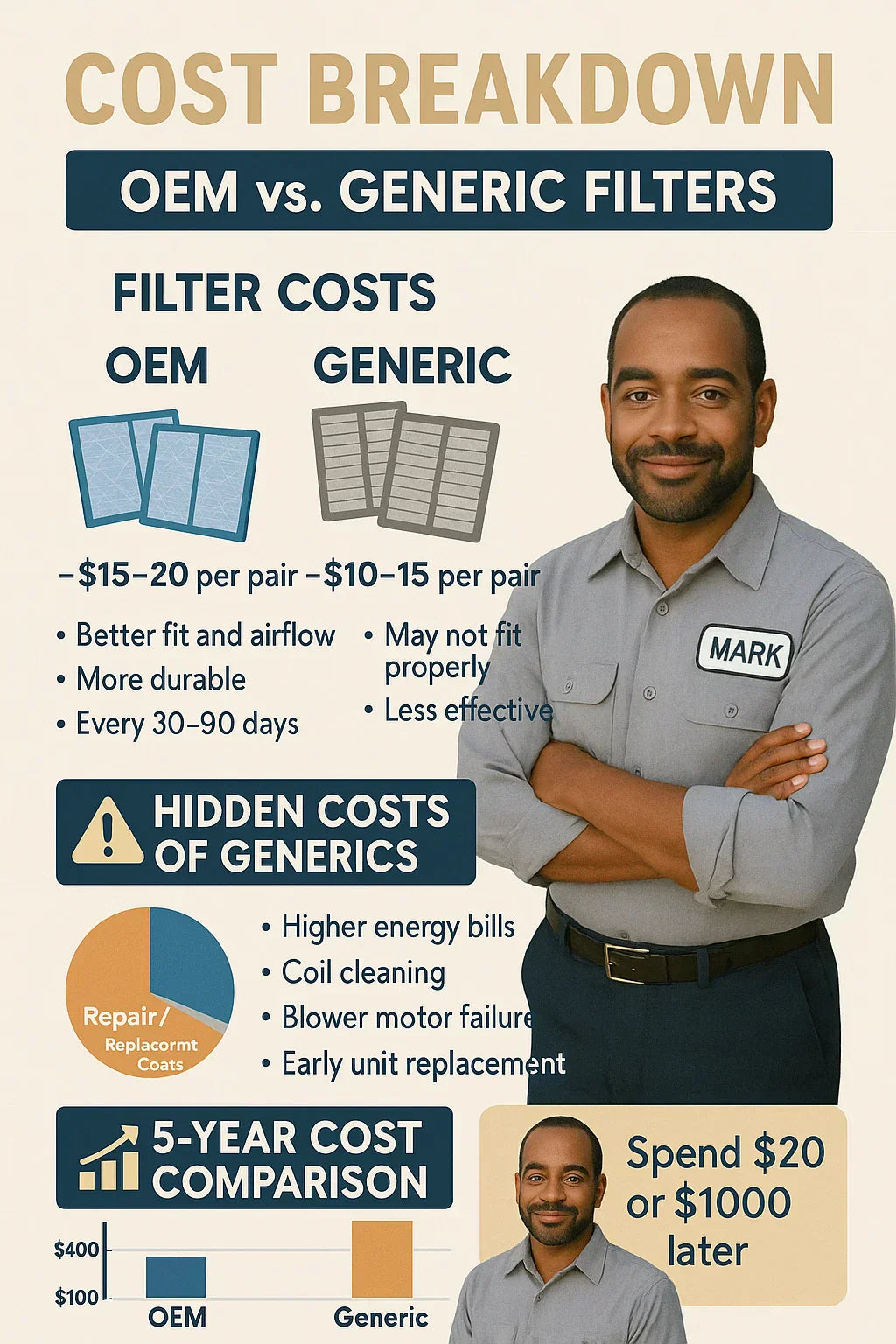📖 Introduction: The “Cheap vs. Smart” Filter Debate
Whenever I’m working with property managers or homeowners, I hear the same thing:
👉 “Why should I spend $20 on an OEM GE Hotpoint filter when I can buy a generic for $10?”
On paper, that question makes sense. Why pay more for what looks like the same piece of mesh? But after 15+ years in the field, I can tell you this:
👉 The cheapest filter up front often ends up being the most expensive in the long run.
This guide breaks down the true cost difference between OEM GE Hotpoint filters and generics, factoring in not just purchase price, but also energy efficiency, repairs, and PTAC lifespan.
🛠️ What OEM GE Hotpoint Filters Really Cost
Upfront Price:
-
Genuine GE Hotpoint OEM replacement filters typically cost $15–$20 per pair.
-
Designed for specific PTAC models, ensuring a perfect fit.
OEM Advantages:
-
🎯 Precision Fit → No air bypass around the edges.
-
🌬️ Balanced Airflow → Captures dust without over-restricting the system.
-
🧪 Durability → Materials hold shape over months of use.
-
🛡️ Warranty Friendly → Using OEM parts keeps manufacturer warranties intact.
📌 Reference: AHRI emphasizes that OEM filters are tested for airflow and system compatibility, unlike many generics .
💡 Mark’s Pro Tip: A $20 OEM filter is cheaper than a $200 service call when a generic lets dust clog your coils.
🪙 What Generic Filters Really Cost
Upfront Price:
-
Generics cost $10–$15 per pair — a savings of $5–$10 each cycle.
Generic Drawbacks:
-
⚠️ Loose Fit → Gaps allow dust to bypass and clog coils.
-
⚡ Over-Restriction → Some filters choke airflow, stressing motors.
-
🗑️ Lower Durability → Cheaper materials warp, collapse, or clog faster.
-
🚫 Warranty Risk → Manufacturers may reject claims if OEM parts aren’t used.
📌 Reference: ENERGY STAR warns that “ill-fitting or overly restrictive filters increase energy use and maintenance costs.”
💡 Mark’s Pro Tip: That $5 savings disappears the first time your blower motor overheats and costs $400 to replace.
⚡ Hidden Costs of Generics: What I See in the Field
Here’s what those “cheap” filters actually cost you:
-
Energy Waste: Systems run longer and harder.
-
Coil Cleaning: $200–$400 per unit when dust bypass clogs coils.
-
Blower Motor Replacement: $300–$500 when over-strained.
-
Compressor Failure: $800–$1200 — usually fatal for the unit.
-
Shortened PTAC Lifespan: 5–7 years instead of 10–12.
📌 Reference: DOE confirms that dirty or restrictive filters increase HVAC energy consumption by 5–15% .
💡 Mark’s Pro Tip: Multiply those hidden costs by 50 or 100 units in a hotel, and you’re looking at tens of thousands in preventable expenses.
📊 5-Year Cost Projection: OEM vs. Generic
Let’s run the numbers for 1 PTAC unit over 5 years:
OEM Filters
-
Average: $20 per pair
-
Replacement: 4x per year (every 3 months)
-
5 years = $400 total filter cost
-
Repairs avoided: Minimal, system lasts longer
Generic Filters
-
Average: $12 per pair
-
Replacement: 4x per year
-
5 years = $240 filter cost (saves $160 vs OEM)
-
BUT:
-
Coil cleaning (at least once): $300
-
Motor replacement (likely): $400
-
Total = $940+
-
Total 5-Year Cost:
-
OEM = $400
-
Generic = $1180+
📌 Reference: U.S. EIA notes HVAC is the largest single expense in building energy use — meaning even small efficiency losses add up quickly.
💡 Mark’s Pro Tip: Saving $160 up front can cost you 3x as much in hidden repairs.
🏨 Hospitality & Property Management: Why This Matters More
In hotels and apartment complexes, the stakes are even higher.
-
100 PTACs with OEM filters (5 years):
-
$400 x 100 = $40,000 filter investment
-
Units last 10–12 years, fewer breakdowns, lower bills
-
-
100 PTACs with generics (5 years):
-
$240 x 100 = $24,000 filter cost (save $16,000 upfront)
-
But add:
-
Coil cleaning $30,000+
-
Motor repairs $40,000+
-
Early replacements $70,000+
-
-
Total = $164,000+
-
📌 Reference: EPA highlights indoor air quality as a top factor in tenant satisfaction — directly tied to filter performance.
💡 Mark’s Pro Tip: In hospitality, one bad review about “musty rooms” can cost more in lost revenue than you’d ever save on generics.
📝 Why OEM = “Insurance in a Box”
Think of OEM filters this way:
-
Cost: $20 each
-
Protection: $1000+ in potential failures
-
Payoff: Longer PTAC lifespan, better air quality, happier guests
OEM filters are basically cheap insurance policies for your PTACs.
✅ Mark’s Recommendations
Here’s what I tell every client:
-
🏠 Homeowners: Always use OEM — the cost difference is too small to risk system damage.
-
🏨 Hotels: Bulk order OEM GE Hotpoint filters. Train staff to swap monthly. Schedule pro service twice a year.
-
🏢 Property Managers: Log replacement schedules across units. OEM filters = consistent performance + tenant satisfaction.
📊 Suggested Visuals
-
Pie chart: OEM vs. Generic — Real Cost Breakdown
-
Line graph: 5-Year Projection (OEM vs. Generic)
-
Infographic: “Spend $20 Now or $1000 Later” with Mark’s installer tip
📝 Conclusion: Mark’s Final Word
The numbers don’t lie:
👉 OEM filters save money in the long run.
Generic filters may save $5 today, but they cost hundreds tomorrow in energy waste, breakdowns, and early replacements.
If you’re serious about protecting your PTACs — and your budget — OEM GE Hotpoint filters are the only smart choice.
In the next topic we will know more about: Seasonal PTAC Maintenance Checklist: Filters, Coils & Drains







